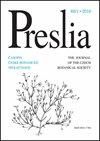Genetically divergent cytotypes of Vaccinium uliginosum co-occurring in the central Eastern Alps can be distinguished based on the morphology of their flowers
IF 4.4
2区 生物学
Q1 PLANT SCIENCES
引用次数: 5
Abstract
The cloudberries (Vaccinium uliginosum s. lat.) are among the most frequent constituents of dwarf shrub communities in the Alps. Recently, we have shown that (i) both diploid and tetraploid cytotypes are widespread in the Eastern Alps and sometimes occur in mixed “populations” and that (ii) these two cytotypes correspond to two non-overlapping AFLP groups, which are in almost perfect congruence with two plastid lineages. Further (iii), we revealed that diploids and tetraploids show some degree of niche separation, but co-occur in low-alpine heath vegetation. Finally, (iv), in spite of the clear separation of diploids and tetraploids in the molecular data sets, we failed to detect consistent morphological differences. Here, we focused on patterns of genetic, ecological and morphological divergence between cytotypes at mixed-ploidy sites as well as on the underlying processes. Our study is based on a sampling of a hundred individuals each at three sites with previously determined co-occurrence of diploids and tetraploids in the Central Alps of Tirol, Austria. We employed an integrative approach combining flow cytometry, plastid DNA sequencing, AFLP fingerprinting, morphometry of leaf and flower characters as well as a characterization of ecological niches based on the vegetation surrounding the individual Vaccinium plants, in order to address the following questions. What is the small-scale distribution of diploid and tetraploid V. uliginosum s. lat. at the three sites investigated? Are the molecular genetic (AFLP and plastid DNA) relationships reflecting the previously detected divergence governed by differences in ploidy level or is there evidence of across-cytotype gene flow in areas of immediate co-occurrence of diploid and tetraploid V. uliginosum s. lat.? Is there evidence for ecological or morphological separation between cytotypes? More specifically, do flower characters allow for a better discrimination between cytotypes than the previously used leaf characters? We show that mixed-ploidy sites are clearly secondary contact zones as based on AFLP markers individuals cluster by cytotype and not by locality. We found no evidence for recent hybridization across the ploidy boundary but the intersection of biparentally inherited recombining AFLPs with maternally inherited plastid DNA sequences provided strong evidence for past inter-ploidy gene flow as one fifth of the tetraploids exhibited a haplotype otherwise restricted to diploids. Further, small-scale ecological segregation between cytotypes was weak, but statistically significant. Leaf characters indicated little differentiation between the cytotypes, whereas flower characters had relatively strong discriminative power. Overall, from a taxonomic point of view, we suggest that clear genome-wide differentiation combined with consistent morphological differences in flower size do not preclude the differentiation of two distinct species (diploid V. gaultherioides and tetraploid V. uliginosum s. str.).根据花的形态特征,可以区分在中东部阿尔卑斯地区共同生长的乌利根(Vaccinium uliginosum)的遗传差异细胞型
云莓(Vaccinium uliginosum s.l at.)是阿尔卑斯山矮灌木群落中最常见的成分之一。最近,我们已经证明(i)二倍体和四倍体细胞型在东阿尔卑斯山广泛存在,有时也出现在混合的“群体”中;(ii)这两种细胞型对应于两个不重叠的AFLP群体,这两个群体与两个质体谱系几乎完全一致。进一步(iii)揭示了二倍体和四倍体在低高寒荒地植被中存在一定程度的生态位分离,但同时存在。最后,(iv)尽管在分子数据集中二倍体和四倍体有明确的分离,但我们未能检测到一致的形态差异。在这里,我们专注于遗传模式,生态和形态分化之间的细胞类型在混合倍体位点以及潜在的过程。我们的研究是基于在奥地利蒂罗尔中部阿尔卑斯山三个地点的100个个体的采样,这些地点先前确定了二倍体和四倍体的共存。为了解决以下问题,我们采用了一种综合的方法,结合流式细胞术、质体DNA测序、AFLP指纹图谱、叶和花的形态测定以及基于单个植株周围植被的生态位表征。二倍体和四倍体的小尺度分布是什么?在被调查的三个地点?分子遗传(AFLP和质体DNA)关系是否反映了先前检测到的由倍性水平差异支配的差异,或者在二倍体和四倍体瞬时共存的区域是否存在跨细胞型基因流动的证据?细胞类型之间是否存在生态或形态上的分离?更具体地说,花性状是否比以前使用的叶性状更能区分细胞类型?我们发现混合倍性位点明显是次级接触区,因为基于AFLP标记,个体是按细胞型而不是按位置聚集的。我们没有发现最近在倍性边界上杂交的证据,但双亲遗传重组aflp与母亲遗传的质体DNA序列的交叉为过去的倍性基因流动提供了强有力的证据,因为五分之一的四倍体表现出单倍体,否则限制为二倍体。此外,细胞型之间的小规模生态分离较弱,但具有统计学意义。叶片性状在细胞型间分化不大,而花性状在细胞型间分化较强。总的来说,从分类学的角度来看,我们认为明确的全基因组分化加上花大小的一致形态差异并不排除两个不同物种(二倍体V. gaultherioides和四倍体V. uliginosum s.str .)的分化。
本文章由计算机程序翻译,如有差异,请以英文原文为准。
求助全文
约1分钟内获得全文
求助全文
来源期刊

Preslia
生物-植物科学
CiteScore
5.20
自引率
29.40%
发文量
8
审稿时长
>12 weeks
期刊介绍:
Preslia is a peer-reviewed scientific journal publishing original research papers on plant systematics, morphology, phytogeography, ecology and vegetation science, with a geographical focus on central Europe. The journal was founded in 1914 and named in honour of brothers Jan Svatopluk Presl (1791–1849) and Karel Bořivoj Presl (1794–1852), outstanding Bohemian botanists. It is published quarterly by the Czech Botanical Society.
 求助内容:
求助内容: 应助结果提醒方式:
应助结果提醒方式:


